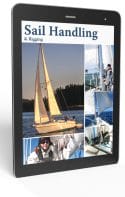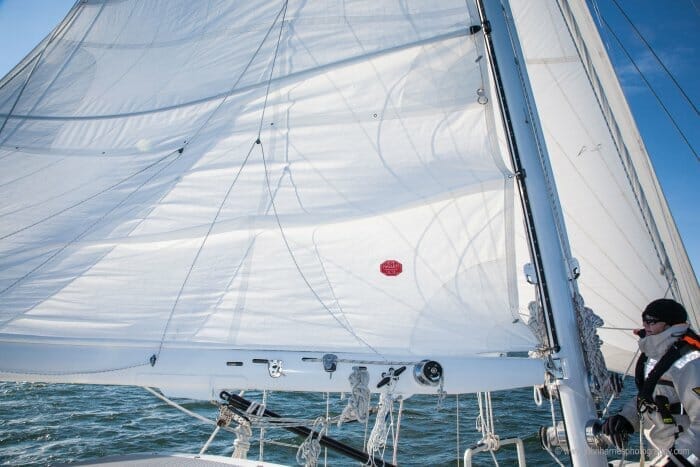Reefing Questions and Answers
8 CommentsReading Time: 3 minutes
More Articles From Online Book: Sail Handling and Rigging Made Easy:
- Be A Master Of The Deck
- Don’t Forget About The Sails
- Sail Buying Tips
- Our Mainsail Is Our Friend
- Hoisting the Mainsail Made Easy—Simplicity in Action
- How Many Reefs and How Deep?
- Reefing Made Easy
- Reefing From The Cockpit 2.0—Thinking Things Through
- Reefing Questions and Answers
- Reefing Tips
- A Dangerous Myth about Reefing
- In-Mast, In-Boom, or Slab Reefing—Convenience and Reliability
- In-Mast, In-Boom, or Slab Reefing —Performance, Cost and Safety
- Mainsail Handling Made Easy with Lazyjacks
- Safe and Easy Offshore Sailing—When to Reef, Part 1
- Safe and Easy Offshore Sailing—When to Reef, Part 2
- Topping Lift Tips and a Hack
- 12 Reasons The Cutter Is A Great Offshore Voyaging Rig
- Cutter Rig—Should You Buy or Convert?
- Cutter Rig—Optimizing and/or Converting
- Cruising Rigs—Sloop, Cutter, or Solent?
- Sailboat Deck Layouts
- The Case For Roller-Furling Headsails
- The Case For Hank On Headsails
- UV Protection For Roller Furling Sails
- Making Life Easier—Roller Reefing/Furling
- Making Life Easier—Storm Jib
- Swept-Back Spreaders—We Just Don’t Get It!
- Q&A: Staysail Stay: Roller Furling And Fixed Vs Hanks And Removable
- Rigid Vangs
- Building A Safer Boom Preventer, Part 1—Forces and Angles
- Building A Safer Boom Preventer, Part 2—Line and Gear Strength Calculator
- Building A Safer Boom Preventer, Part 3—The Details
- Why We Don’t Recommend Boom Brakes
- Downwind Sailing, Tips and Tricks
- Downwind Sailing—Poling Out The Jib
- Setting and Striking a Spinnaker Made Easy and Safe
- Ten Tips To Fix Weather Helm
- Running Rigging Recommendations—Part 1
- Running Rigging Recommendations—Part 2
- Two Dangerous Rigging Mistakes
- Rig Tuning, Part 1—Preparation
- Rig Tuning, Part 2—Understanding Rake and Bend
- Rig Tuning, Part 3—6 Steps to a Great Tune
- Rig Tuning, Part 4—Mast Blocking, Stay Tension, and Spreaders
- Rig Tuning, Part 5—Sailing Tune
- Cruising Sailboat Spar Inspection
- Cruising Sailboat Standing Rigging Inspection
- Cruising Sailboat Running Rigging Inspection
- Cruising Sailboat Rig Wiring and Lighting Inspection
- Cruising Sailboat Roller Furler and Track Inspection
- Download Cruising Sailboat Rig Checklist
- 9 Tips To Make Unstepping a Sailboat Mast Easier
- Rigging Tips Part 1
- Rigging Tips Part 2



I have come across a clip by Skip Novak on Youtube . His mainsail reefing system is slightly different than yours and both are proven in tough conditions. If you have seen this I would welcome your observations on the differences.
Hi Chris,
I have seen that video, although not for some time. I have huge respect for Skip having sailed with him some 35 years ago, long before his charter business. So first off you should know that Skip is one of the toughest people I have ever met and that means that things that are good for him may not be good for a wimp like me.
In watching his heavy weather videos, not just reefing, the key difference between his approach and ours is that almost all of his techniques assume a strong relatively large tough crew, whereas ours were developed by and for an aging couple.
On details, a key difference between Skip’s system and ours is we have three reefs and a trysail and he four and no trysail. This again is influenced by the difference in crew. He has the resources to wrestle a damaged main and repair it, even in really bad conditions, we don’t. So we like to have a spare main (trysail) ready to go at all times.
One more point. Whether one has three or four reefs is a lot less significant that people think. The key issue is how deep the deepest reef is. More here:
https://www.morganscloud.com/2025/02/16/reefs-how-many-and-how-deep/
Hello John,
Having read again your excellent articles about the importance of reliable mainsail reefing downwind. To avoid going the upwind route in heavy weather seems very appealing.
We have a HR46 with hydraulic inmast furling and I am trying to adapt and practice reefing going downwind. For the moment I have always gone upwind when above 10 knots.
I know your prevention regarding these furling systems vs slab reefing. Nevertheless a good number of reputable offshore cruising boats have these systems.
Would you or an other well weathered give a few tips for the offshore use in heavy weather to reef downwind with inmost furling system.
My questions are while going downwind:
I hope my questions are not a recipe list to disaster and probably interest many readers of AAC that have in mast furling.
Best regards.
Denis
Hi Denis,
Great questions. As it happens, I just finished the, research for, and first draft of, a massive (nearly 4000 words) buyer’s guide to mainsail handling systems, which covers most of those questions. Look for it in about 10 days.
Hi. I seem to always get the reefed bunt of the sail caught in between the clew eyelet and the reef line when I’m cranking it in. This means I have to move away from the mast and towards the end of the boom to pull it free or arrange the bunt of the sail differently. One tack is always easier, as the wind pushes the bunt away from the boom and reef line, but the other tack will have the wind pushing it towards the reef line.
On the first reef, I even need to lean over the side to reach it (or sheet the boom in too hard). If I’m sailing upwind while reefing, it’s a bit less of a problem, but then it’s a much more dangerous procedure to fix if it gets caught, since the boom can move, sometimes quite violently. So it’s not a desirable thing to do anyway. If the conditions are too rough, I tend to not crank in the reefing line all the way, but this means I don’t really get the foot as tight as I would like. Not a huge issue downwind, but more if going upwind.
Is there any tips on avoiding this, or I just need to live with it?
Thanks, Arne.
Hi Arne,
Yes, that can be a problem with some set ups. A solution is to move all sheaves to the aft end of the boom well clear of the bunt. Then reefing line is dead ended where we want the reef clew to end up: https://www.morganscloud.com/jhhtips/dead-ending-reefing-pennants/
Hi John, thanks for a swift reply!
This is pretty much my exact setup. The problem is the line that goes from the dead end on the boom, and up to the eyelet on the reef-clew, works as kind of a “lazyjack”, catching the sail (mainly on the tack opposite the side of the reef line). When I then crank it in, a part of the bunt tends to get pulled through the eyelet with the rope if I’m not careful.
I don’t really see much solution to this other than manually pulling the sail out away, and/or leaving a bit of slack on the reef line, so that I don’t pull the new clew all the way down to the boom.
The slack-method works, but I feel that the sail is not really flat enough (or I could move the dead end further aft on the boom, but that’s not ideal either), and it cause the boom to “drop”, decreasing the distance between the boom and the water (just at the time when I want the boom even higher with the building sea state).
Anyway, I guess this is just something I have to live with. I just had a faint hope that you would have a magical solution that would fix this…. 😉
Thanks, Arne 🙂
Hi Arne,
I definitely would not leave any slack in the line. When reefing we are trying to reduce healing force and having a slack foot makes the sail more full doing the opposite of what we want.
One solution is to always reef on the tack so the bunt of the sail falls away from dead end of the line. Not ideal, but it does work. Another trick is a swift yank forward on the bunt before the clew comes fully tight, which can be done from the mast.